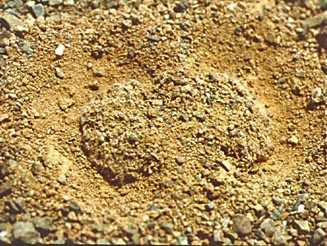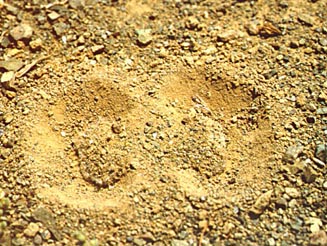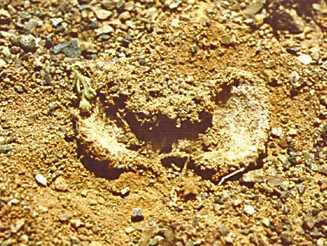|
Genus: Seothyra (buck spoor spiders)
Life
> Eukaryotes
>
Opisthokonta >
Metazoa
(animals) > Bilateria > Ecdysozoa > Panarthropoda > Tritocerebra >
Arthropoda > Arachnomorpha > Cheliceriformes > Chelicerata > Euchelicerata
> Arachnida > Araneae
> Araneomorpha > Family: Eresidae
The genus Seothyra is often overlooked in
the field. The nest is easily mistaken for an animal spoor and the spider is
often referred to as the buck spoor spider. It is a southern African endemic
(only occurs in this region) and includes 13 species that occur in sandy arid
areas, 5 of which occur in South Africa.
|

|

|
|
 |

|
|
|
Buck spoor nest of where the sand has been removed to expose the silk. |
|
The above photographs of the
buck spoor nest of Seothyra sp. were
taken by Dr VB Whitehead on 26 October 1998 at Rietfontein store, 25 km
north of Prince Albert Road on N2 (3221DD). |
The genus Seothyra is sexually dimorphic
(males and females have a different appearance). The bulky, sedentary females
are cream, brown or grey and 6-15 mm in length and the oval abdomen is plain or
banded. The cephalic region (head area) is raised. The males range in size from
4-12mm and are cursorial (running) spiders, active in the heat of the day. They
mimic the Camponotus ant (sugar ant) or mutillid wasps (velvet ants) in both
appearance and movements. The cephalic region in the males slopes more steeply
than the females and the anterior (front) legs are enlarged. The carapace is
yellow, brown or rust while the abdomen is covered in black and white setae,
resulting in white oval or round patches than can be used to identify species.
The female constructs her burrow 50-150 mm into
the sand at the top of which is the shallow depression. The female constructs a
sheet of cribellate silk ingrained with the local sand rendering it invisible.
The mat-like trapdoor has 2 to 4 depressions resembling a hoof imprint. The
female waits in her burrow and uses a single strand of silk to detect vibrations
of prey above at which time she darts out and overpowers the prey crossing her
web. Seothyra may also hang inverted underneath the sheet web. Both males
and females are most active on hot days when the ground temperature is about 65
degrees centigrade.
Text by Norman Larsen ©. |
